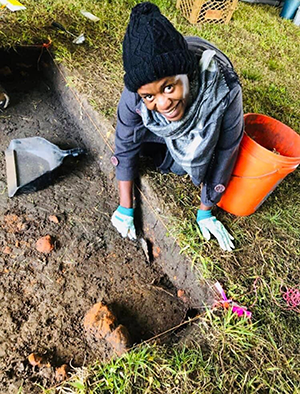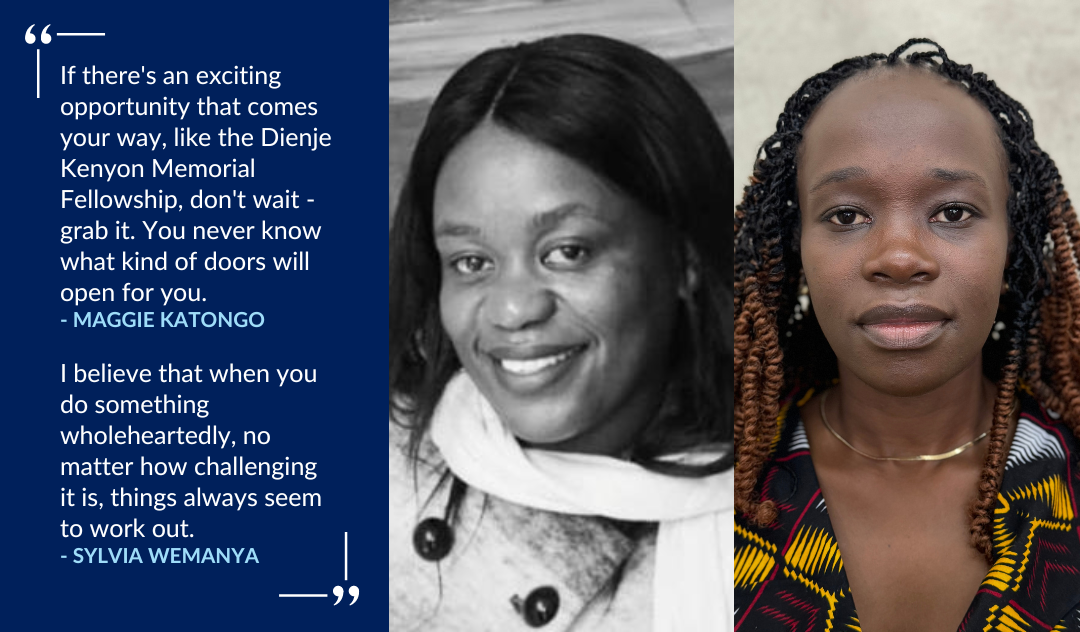The Society for American Archaeology (SAA) recently announced the 2024 winners of the Dienje Kenyon Memorial Fellowship, marking the second consecutive year that the award has been given to archaeology students in the anthropology department of Rice’s School of Social Sciences. Maggie Katongo and Sylvia Wemanya were awarded the fellowship in 2024 and 2023, respectively.
“This is a major recognition from our field’s most prominent professional organization,” said Mary Prendergast, associate professor of anthropology. “It is a real testament to our PhD program that Rice archaeology students have won it two years in a row.”
The Dienje Kenyon Memorial Fellowship is awarded annually to a graduate student studying archaeology. The fellowship was created in honor of the late Dienje M. E. Kenyon to support women who are beginning to embark on training in zooarchaeology, the study of ancient animal remains. Each award recipient receives $2,000 to support their research.
Katongo and Wemanya recently sat down and discussed their research supported by the fellowship, their experiences at Rice, and their plans for the future.
 Maggie Katongo
Maggie Katongo
While serving as a curator of archaeology at the Livingstone Museum in Zambia, Maggie Katongo was introduced to Jeff Fleisher, professor of anthropology. Katongo, who was working on her master’s degree in ceramics, provided Fleisher with research support on his project. Her experience as part of this collaboration motivated Katongo to apply to Rice’s anthropology doctoral program, where she now studies fauna material within the scope of a larger project in the Kafue River Basin.
“With regard to tracing past migration patterns of people, there are researchers who focus on plants, metals, or beads, to name a few examples,” said Katongo, “My focus is on animals because in the area where I work, animals move seasonally, and what better way to trace mobility?”
Katongo explained that in the past, people responded to seasonal changes by following animals to procure them for food, use them in rituals, and offer them for trade. Researchers have often focused on the large-scale migration of the Bantu peoples, tracing them from West Central Africa down to South Central Africa. Katongo’s research addresses the micro-movements of people, for example, examining what happened after the Bantu migration. To address this, Katongo works with materials that are mostly comprised of various animal bones from the Iron Age.
As Zambia does not have the tools necessary to support the analysis of her research materials, Katongo will analyze her materials in South Africa, which has a reference collection that can help with species identifications. Thus, Katongo must physically move the materials from Zambia to South Africa, which incurs a cost.
In seeking out support for her research, Katongo applied for the Dienje Kenyon Memorial Fellowship.
“The fellowship is going to help me carefully move these treasured possessions to South Africa,” said Katongo. “Because the materials are very fragile, I do not want to export them using commercial transportation. The solution is to rent a truck with a trailer, package everything, cushion the items, and then move them for 24 hours, passing through Botswana, and ending in South Africa.”
Katongo found that the application for the fellowship was straightforward, noting how helpful and communicative the SAA was during the process. She expressed her gratitude for the funding, and she advises other students to apply without hesitation.
“If there's an exciting opportunity that comes your way, like the Dienje Kenyon Memorial Fellowship, don't wait - grab it,” said Katongo. “You never know what kind of doors will open for you.”
In looking to the future, Katongo is excited for where her Rice doctorate in anthropology may lead her and is keeping her options open. She loves being a curator for the museum, and she also is excited to continue her research and share what she has learned with others. Additionally, from the knowledge Katongo has gained in researching fauna materials, she is becoming more interested in knowing about animal diseases.
“Right now, we know how people treat animal diseases,” said Katongo. “There are all these conventional methods being used, but I would like to learn more about how people in the past were managing their livestock, ensuring that they multiply, and getting rid of diseases.”
Katongo strongly encourages prospective students who are interested in archaeology to apply for Rice’s graduate program in anthropology.
“It’s the best place to be because the support system is so great, and there are so many wonderful opportunities for students,” said Katongo. “Rice opens students up to unique experiences and helps to build networks that will last a lifetime.”

Sylvia Wemanya
Growing up, Sylvia Wemanya always had a particular interest in animals and history. Pursuing an education in anthropology, therefore, was a natural path to take. After graduating with a degree in anthropology at the University of Nairobi, Wemanya attended Koobi Fora, the first field school in northern Kenya. After connecting with Prendergast, Wemanya applied to Rice’s anthropology program.
As a graduate student, Wemanya has positioned her research within the Holocene, which refers to the last 10,000 years on earth. In particular, she is studying a foraging society in East Africa along the shores of Lake Victoria and the introduction of pastoralism. Wemanya is interested in understanding the community’s interactions and whether it had exchange networks or implemented new subsistence strategies.
“In this area of research, archaeologists have focused mostly on subsistence, like what people were eating,” said Wemanya. “Personally, I believe that when you look at modern day humans, we interact with animals at more levels than just feeding. We also look at them as sources of service and rituals, for example. I would like to see if we can find similarities in the archaeological record.”
Upon the recommendation of Prendergast, Wemanya applied for the Dienje Kenyon Memorial Fellowship. Even as a first-year student, she felt that the courses she had taken at Rice had already provided her with enough knowledge to feel confident about applying.
The grant helped support Wemanya’s accommodations as she administered laboratory research in Nairobi. The funding also enabled her to go to the museum every other day to explore its collections and locate specimens that had been identified as domesticates, such as goats, sheep, and cows.
During her laboratory work, Wemanya put together a collection of previously identified domesticates. The collection is awaiting permits from the National Museums of Kenya to be shipped to the United States, where she will utilize a newer method of analysis, Zooarchaeology by Mass Spectrometry (ZooMS).
“Because humans are very subjective, sometimes we identify things and make errors,” said Wemanya. “Some of these animals have many similarities, and it can be difficult to differentiate them. ZooMS allows for a refined identification of these animals to the species level. Being able to tell that, for example, this is a sheep and not a goat or some other wild bovid, enables us to ascertain that, indeed, this community relies on these domesticated animals.”
The next step of the process, Wemanya explained, is carrying out direct radiocarbon dating on the bones so that the chronological sequences are not mixed up, which allows archaeologists to exactly pinpoint particular occurrences to specific points in time and have a more refined narrative.
“I'm so grateful that I was awarded the fellowship because I'm now in a better position with my research,” said Wemanya. “I had some funding leftover from last year, and so this summer, I have been able to return to Kenya and continue working on these materials.”
After graduation, Wemanya hopes to return to Kenya to train more archaeologists either at a university or at the National Museums of Kenya.
“Serving in a position where I can get this important information out to a wider audience and train more people to have a better understanding of archaeology in Kenya is my long-term goal,” said Wemanya.
Wemanya advises budding archaeologists who are interested in Rice’s anthropology program to make sure they are passionate about the subject, give it their all, stay focused, expand their networks, and stay true to themselves.
“I believe that when you do something wholeheartedly, no matter how challenging it is, things always seem to work out,” Wemanya added.

